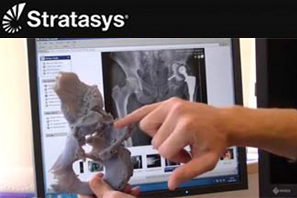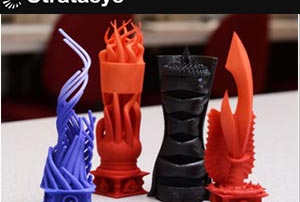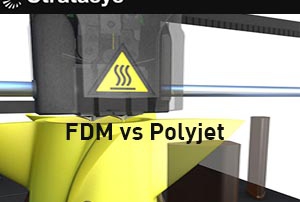3D Printed Surgical Models Improving Implant Surgery While Saving Time and Money in Twelve UK Hospitals
To understand why 3D printed surgical guides are making such an impact on medical procedures, you need look no further than Replica 3DM. This innovative supplier of medical and commercial 3D printed models is using its Stratasys 3D Printers to support 12 UK National Health Service (NHS) hospitals. The surgical models produced on the company’s Objet24 and Objet30 Pro 3D Printers allow surgeons to accurately test intended implants prior to surgery. As a result, the hospitals have seen a decrease in the length of surgical procedures leading to substantial reductions in operating room costs. It’s What You Don’t See Replica 3DM’s Stratasys 3D Printers convert patient CT scans into physical 3D printed models. The materials used and special finishing processes enable surgeons to carry out precise pre-operative planning. By providing accurate visualization of anatomy including fragment position, the 3D printed models display important features that cannot always be seen in two dimensional images. “Sometimes conceptually and spatially, it’s difficult looking on a computer screen to establish the exact dimensions of the bone that is available to you for surgery,” said Alistair Morton, a surgeon in the Oral and Maxillofacial Surgery Department at the hospital. “So this is one of the areas where having a 3D [...]
Capturing imaginations through 3-D printing
Reprinted from Business Weekly. By Erin Negley Reading Eagle Watch a video of the 3-D printing process The unusual pieces might look like artful jewelry, but Joceyln Kolb likes to call what she does body adornment, more Princess Leia than Elizabeth Taylor. The forms she creates have a backstory and are inspired by things such as the glow of deep-sea coral. To make these intricate pieces, Kolb traded her metalsmithing tools for a $30,000 3-D printer. This Albright College professor now works on a computer-aided design program to create art that would be nearly impossible to make by hand. Tucked away in a former closet, the printer sprays 32-micron layers of plastic resin, about half the thickness of a human hair. “Builds” take hours and sometimes days, but the finished products are complex pieces with moveable parts. The machine’s expensive and not perfect, but 3-D printing carries huge potential for art and design and business applications. Additive manufacturing technology has taken hold in industries including defense, automotive and manufacturing over the past decade. Similar to a printer that prints two-dimensional files onto paper, a 3-D printer layers material (usually plastic) to create a three-dimensional product. Jay Leno has his own 3-D printer to [...]
Stratasys Presents a 3D Printed Aircraft Interior at EuroMold 2014
Join Fred Fisher, Director of PolyJet and FDM Applications at Stratasys, as he presents a real aircraft interior 3D printed using a unique combination additive manufacturing technologies. The presentation was filmed at Stratasys' aerospace-themed booth at EuroMold 2014 in Frankfurt. [pardot-form id="6642" title="Stratasys info new products"]
Stratasys Goes All Out, Announces 12 New High-performance 3D Printers and Materials
Reprinted from 3DPrint.com Stratasys, with dual headquarters in Eden Prairie, Minnesota and Rehovot, Israel, has announced 12 new high-performance 3D printers and materials, in a move which should provide investors with renewed confidence in their rapidly growing business. The new products, which will be unveiled at EuroMold 2014, at the end of this month, include upgrades and an expansion in the company’s scope to new areas of the market. “The global design and manufacturing market continues to push toward creating smarter products with greater efficiency. Because we believe in, and support this trend, we have announced today a range of solutions that focus on ‘democratizing design.’ Our customers, whatever their size or industry, can now access a wide spectrum of cutting-edge 3D printing capabilities and deliver competitive advantage,” said Gilad Yron, sr. vice president, Product Management, Stratasys. “We invite every designer and manufacturer at this year’s EuroMold to visit one of our three booths to see how 3D printing is shaping the way we manufacture.” 6 New Industrial PolyJet 3D Printers Included in this expansion are six new PolyJet 3D printers targeting customers who are looking for more affordable, but smaller machines. The new printers include the compact Objet260 Connex1, Objet260 Connex2 and [...]
3D Printing Central to Nike’s Continued Growth According to CEO Parker
Reprinted from 3dprint.com Innovation, innovation, innovation is the manufacturer’s equivalent to the well-known real estate mantra. Top performers like Nike don’t get the luxury of duplicating cookie cutter condos year after year. From moment to moment, the company has to deliver the new with a breakthrough nexus. At a company known for innovation and acute attention to feedback from its customers, Nike president Mike Parker sees innovation in manufacturing as a key component for the continued success of the company. Manufacturing is brand and innovation intensive, and with one of the world’s best known brands, Nike is always on the prowl for the next inventive product. Constantly pushing the envelope of new materials, textures, concepts and design testing keeps the company riding the cutting edge of sportswear development. There is a never-ending winnowing process to get the best ideas and processes for maintaining company growth year after year. Sports equipment and apparel is among the most competitive business sectors, so change is constant. Redirecting its manufacturing processes with innovative initiatives keeps the sports juggernaut focused on new products, how the products are made and what they are made from. “It’s not only a place where we can see some margin opportunity by scaling [...]
FDM and PolyJet 3D Printing: Determining Which Technology is Right for Your Application
There’s recently been a lot of news about FDM (Fused Deposition Modeling) and PolyJet 3D printing technologies. So, when entering the market for an additive manufacturing system, it’s beneficial to have a deeper understanding of the differences between the two technologies to select the 3D printer with the right set of capabilities for your business. After all, each technology builds parts its own way and each provides a variety of attractive benefits and capabilities. Say that you can only choose one technology or that you need another 3D printer but are not sure if you need the same technology or an alternative. How do you sort it out? Today’s Check it Out takes you to a complimentary white paper that’s intended to help you research wisely. The elevator speech on “FDM and PolyJet 3D Printing: Determining Which Technology is Right for Your Application” is that it compares FDM and PolyJet technologies using three criteria: operations, part characteristics and materials. It’s richly illustrated with figures, charts, graphs, screenshots and photos. It’s written for anyone with a basic understanding of 3D printing. It’s not an in-depth theoretical presentation. Every bit of it is a hands-on “what’s in it for you” document. This seven-page white paper, [...]





